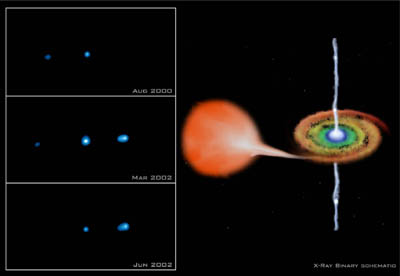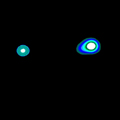Imagine the Universe News - 13 November 2002
Chandra Discovers The History Of Black Hole X-Ray Jets
| 13 November 2002 |
For the first time, astronomers have tracked the life cycle of X-ray jets from a black hole. A series of images from NASA's Chandra X-ray Observatory revealed the jets traveled at near light speed for several years before slowing down and fading.
"Watching these jets slow down and disappear is like watching a time-lapse movie of the rise and fall of the Bronze Age," said Stephane Corbel of the University of Paris VII and the French Atomic Energy Commission in Saclay, lead author of the paper in the Oct. 4 issue of the journal Science. "Since the jets came from a stellar black hole in our galaxy, we watched, in only a few years, developments that would have taken thousands of years to occur around a supermassive black hole in a distant galaxy," he said.

|
|
A series of Chandra images has allowed scientists to trace the evolution of large-scale X-ray jets produced by a black hole in a binary star system. As the schematic shows, gaseous matter pulled from a normal star forms a disk around the black hole. The gas is heated to temperatures of millions of degrees, and intense electromagnetic forces in the disk can expel jets of high-energy particles. (Click to see a larger image) Credit: Left: X-ray (NASA/CXC); Right: Illustration (CXC/M.Weiss) |
Astronomers have been using Chandra and radio telescopes to observe two opposing jets of high-energy particles emitted following an outburst, first detected in 1998 by NASA's Rossi X-ray Timing Explorer, from the double-star system XTE J1550- 564. The X-ray jets, which require a continuous source of trillion-volt electrons to remain bright, were observed moving at about half the speed of light (approximately 93,000 miles per second). Four years later, they are more than three light-years apart, slowing down and fading.
"The ejection of jets from stellar and supermassive black holes is a common occurrence in the universe, so it is extremely important to understand the process," said John Tomsick of the University of California, San Diego. He is the author of an Astrophysical Journal paper scheduled for January 2003 publication describing the research. "For the first time, we have observed a jet from the initial explosion until it slowed and faded," he said.
|
The observations indicate that one jet, the eastern jet, is moving along a line tilted toward the Earth, whereas the western jet is pointed away from the Earth. This alignment explains why the eastern jet appears to have traveled farther from the black hole than the western one. However, with this alignment, the eastern jet should be brighter than the western one, while the western jet was actually three times brighter.
"This poses a puzzle. The simple model for jets doesn't explain what we are seeing," said Phil Kaaret of the Harvard- Smithsonian Center for Astrophysics in Cambridge, Mass., and lead author of another upcoming Astrophysical Journal paper on XTE J1550-564. "Either the black hole may somehow be feeding more energy into the western jet, or that jet has run into a dense cloud," he said.
|
As jets plow through the interstellar gas, the resistance of the gas slows them down like air resistance slows down moving objects on Earth. Although all jets are believed to decelerate in this way, the observations of XTE J1550-564 mark the first time jets have been caught in the act of slowing down. The observed deceleration underscores the value of small, stellar black holes in our galaxy for studying similar processes that occur in distant quasars and active galactic nuclei.
XTE J1550-564, which is about 17,000 light-years from Earth, was observed with Chandra's Advanced CCD Imaging Spectrometer and the High Energy Transmission Grating instruments. Radio data used in this study were obtained by the Australia Telescope Compact Array.



